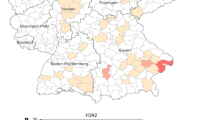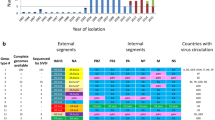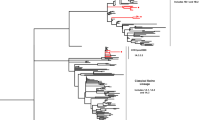Abstract
In 2009, two H1N2 influenza viruses were isolated from trachea swabs of pigs in Hubei in China. We compared these sequences with the other 18 complete genome sequences of swine H1N2 isolates from China during 2004 to 2010 and undertook extensive analysis of their evolutionary patterns. Six different genotypes – two reassortants between triple reassortant (TR) H3N2 and classical swine (CS) H1N1 virus, three reassortants between TR H1N2, Eurasian avian-like H1N1 swine virus and H9N2 swine virus, and one reassortant between H1N1, H3N2 human virus and CS H1N1 virus – were observed in these 20 swine H1N2 isolates. The TR H1N2 swine virus is the predominant genotype, and the two Hubei H1N2 isolates were located in this cluster. We also used a mouse model to examine the pathogenesis and inflammatory responses of the two isolates. The isolates replicated efficiently in the lung, and exhibited a strong inflammatory response, serious pathological changes and mortality in infected mice. Given the role that swine can play as putative “genetic mixing vessels” and the observed transmission of TR H1N2 in ferrets, H1N2 influenza surveillance in pigs should be increased to minimize the potential threat to public health.





Similar content being viewed by others
References
Brown IH (2000) The epidemiology and evolution of influenza viruses in pigs. Vet Microbiol 74:29–46
Webby RJ, Swenson SL, Krauss SL, Gerrish PJ, Goyal SM, Webster RG (2000) Evolution of swine H3N2 influenza viruses in the United States. J Virol 74:8243–8251
Sugimura T, Yonemochi H, Ogawa T, Tanaka Y, Kumagai T (1980) Isolation of a recombinant influenza virus (Hsw 1 N2) from swine in Japan. Arch Virol 66:271–274
Gourreau JM, Kaiser C, Valette M, Douglas AR, Labie J, Aymard M (1994) Isolation of two H1N2 influenza viruses from swine in France. Arch Virol 135:365–382
Brown IH, Chakraverty P, Harris PA, Alexander DJ (1995) Disease outbreaks in pigs in Great Britain due to an influenza A virus of H1N2 subtype. Vet Record 136:328–329
Brown IH, Harris PA, McCauley JW, Alexander DJ (1998) Multiple genetic reassortment of avian and human influenza A viruses in European pigs, resulting in the emergence of an H1N2 virus of novel genotype. J Gen Virol 79(Pt 12):2947–2955
Karasin AI, Olsen CW, Anderson GA (2000) Genetic characterization of an H1N2 influenza virus isolated from a pig in Indiana. J Clin Microbiol 38:2453–2456
Qi X, Lu CP (2006) Genetic characterization of novel reassortant H1N2 influenza A viruses isolated from pigs in southeastern China. Arch Virol 151:2289–2299
Ali A, Khatri M, Wang L, Saif YM, Lee CW (2012) Identification of swine H1N2/pandemic H1N1 reassortant influenza virus in pigs, United States. Vet Microbiol 158:60–68
Balint A, Metreveli G, Widen F, Zohari S, Berg M, Isaksson M, Renstrom LH, Wallgren P, Belak S, Segall T, Kiss I (2009) The first Swedish H1N2 swine influenza virus isolate represents an uncommon reassortant. Virol J 6:180
Lam TY, Hon CC, Wang Z, Hui RK, Zeng F, Leung FC (2008) Evolutionary analyses of European H1N2 swine influenza A virus by placing timestamps on the multiple reassortment events. Virus Res 131:271–278
Moreno A, Di Trani L, Faccini S, Vaccari G, Nigrelli D, Boniotti MB, Falcone E, Boni A, Chiapponi C, Sozzi E, Cordioli P (2011) Novel H1N2 swine influenza reassortant strain in pigs derived from the pandemic H1N1/2009 virus. Vet Microbiol 149:472–477
Schrader C, Suss J (2003) Genetic characterization of a porcine H1N2 influenza virus strain isolated in Germany. Intervirology 46:66–70
Vincent AL, Ma W, Lager KM, Gramer MR, Richt JA, Janke BH (2009) Characterization of a newly emerged genetic cluster of H1N1 and H1N2 swine influenza virus in the United States. Virus Genes 39:176–185
Reed LJMH (1938) A simple method of estimating fifty percent endpoints. Am J Hyg 27:493–497
Livak KJ, Schmittgen TD (2001) Analysis of relative gene expression data using real-time quantitative PCR and the 2(-Delta Delta C(T)) Method. Methods (San Diego) Calif 25:402–408
Tate MD, Deng YM, Jones JE, Anderson GP, Brooks AG, Reading PC (2009) Neutrophils ameliorate lung injury and the development of severe disease during influenza infection. J Immunol 183:7441–7450
Dunham EJ, Dugan VG, Kaser EK, Perkins SE, Brown IH, Holmes EC, Taubenberger JK (2009) Different evolutionary trajectories of European avian-like and classical swine H1N1 influenza A viruses. J Virol 83:5485–5494
Smith GJ, Vijaykrishna D, Bahl J, Lycett SJ, Worobey M, Pybus OG, Ma SK, Cheung CL, Raghwani J, Bhatt S, Peiris JS, Guan Y, Rambaut A (2009) Origins and evolutionary genomics of the 2009 swine-origin H1N1 influenza A epidemic. Nature 459:1122–1125
Brown IH, Ludwig S, Olsen CW, Hannoun C, Scholtissek C, Hinshaw VS, Harris PA, McCauley JW, Strong I, Alexander DJ (1997) Antigenic and genetic analyses of H1N1 influenza A viruses from European pigs. J Gen Virol 78(Pt 3):553–562
Zell R, Motzke S, Krumbholz A, Wutzler P, Herwig V, Durrwald R (2008) Novel reassortant of swine influenza H1N2 virus in Germany. J Gen Virol 89:271–276
Xu C, Zhu Q, Yang H, Zhang X, Qiao C, Chen Y, Xin X, Chen H (2009) Two genotypes of H1N2 swine influenza viruses appeared among pigs in China. J Clin Virol 46:192–195
Yu H, Zhang PC, Zhou YJ, Li GX, Pan J, Yan LP, Shi XX, Liu HL, Tong GZ (2009) Isolation and genetic characterization of avian-like H1N1 and novel ressortant H1N2 influenza viruses from pigs in China. Biochem Biophys Res Commun 386:278–283
Kong WL, Huang LZ, Qi HT, Cao N, Zhang LQ, Wang H, Guan SS, Qi WB, Jiao PR, Liao M, Zhang GH (2011) Genetic characterization of H1N2 influenza a virus isolated from sick pigs in Southern China in 2010. Virol J 8:469
Seo SH, Webby R, Webster RG (2004) No apoptotic deaths and different levels of inductions of inflammatory cytokines in alveolar macrophages infected with influenza viruses. Virology 329:270–279
Van Reeth K, Nauwynck H, Pensaert M (2001) Clinical effects of experimental dual infections with porcine reproductive and respiratory syndrome virus followed by swine influenza virus in conventional and colostrum-deprived pigs. J Vet Med 48:283–292
Arndt U, Wennemuth G, Barth P, Nain M, Al-Abed Y, Meinhardt A, Gemsa D, Bacher M (2002) Release of macrophage migration inhibitory factor and CXCL8/interleukin-8 from lung epithelial cells rendered necrotic by influenza A virus infection. J Virol 76:9298–9306
Cheung CY, Poon LL, Lau AS, Luk W, Lau YL, Shortridge KF, Gordon S, Guan Y, Peiris JS (2002) Induction of proinflammatory cytokines in human macrophages by influenza A (H5N1) viruses: a mechanism for the unusual severity of human disease? Lancet 360:1831–1837
Swiergiel AH, Dunn AJ (1999) The roles of IL-1, IL-6, and TNFalpha in the feeding responses to endotoxin and influenza virus infection in mice. Brain Behavior Immunity 13:252–265
Lehmann C, Sprenger H, Nain M, Bacher M, Gemsa D (1996) Infection of macrophages by influenza A virus: characteristics of tumour necrosis factor-alpha (TNF alpha) gene expression. Research in virology 147:123–130
Jo SK, Kim HS, Cho SW, Seo SH (2007) Pathogenesis and inflammatory responses of swine H1N2 influenza viruses in pigs. Virus Res 129:64–70
Acknowledgments
This research was funded by China National Basic Research Program (China “973” Program 2011CB505004), National Natural Science Foundation of China (No. 31072154) and Fundamental Research Funds for the Central Universities (2011PY126). Special thanks also go to Ms. Anna Cauldwell and Ms. Xiao Xiao for critically reading the manuscript.
Author information
Authors and Affiliations
Corresponding author
Rights and permissions
About this article
Cite this article
Zhang, Y., Wang, N., Cao, J. et al. Genetic characterization of H1N2 swine influenza virus isolated in China and its pathogenesis and inflammatory responses in mice. Arch Virol 158, 1965–1972 (2013). https://doi.org/10.1007/s00705-013-1685-8
Received:
Accepted:
Published:
Issue Date:
DOI: https://doi.org/10.1007/s00705-013-1685-8




